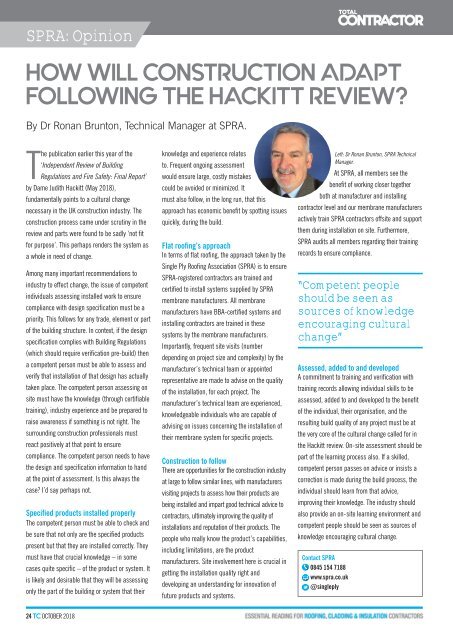October 2018
You also want an ePaper? Increase the reach of your titles
YUMPU automatically turns print PDFs into web optimized ePapers that Google loves.
SPRA: Opinion<br />
HOW WILL CONSTRUCTION ADAPT<br />
FOLLOWING THE HACKITT REVIEW?<br />
By Dr Ronan Brunton, Technical Manager at SPRA.<br />
The publication earlier this year of the<br />
‘Independent Review of Building<br />
Regulations and Fire Safety: Final Report’<br />
by Dame Judith Hackitt (May <strong>2018</strong>),<br />
fundamentally points to a cultural change<br />
necessary in the UK construction industry. The<br />
construction process came under scrutiny in the<br />
review and parts were found to be sadly ‘not fit<br />
for purpose’. This perhaps renders the system as<br />
a whole in need of change.<br />
Among many important recommendations to<br />
industry to effect change, the issue of competent<br />
individuals assessing installed work to ensure<br />
compliance with design specification must be a<br />
priority. This follows for any trade, element or part<br />
of the building structure. In context, if the design<br />
specification complies with Building Regulations<br />
(which should require verification pre-build) then<br />
a competent person must be able to assess and<br />
verify that installation of that design has actually<br />
taken place. The competent person assessing on<br />
site must have the knowledge (through certifiable<br />
training), industry experience and be prepared to<br />
raise awareness if something is not right. The<br />
surrounding construction professionals must<br />
react positively at that point to ensure<br />
compliance. The competent person needs to have<br />
the design and specification information to hand<br />
at the point of assessment. Is this always the<br />
case? I’d say perhaps not.<br />
Specified products installed properly<br />
The competent person must be able to check and<br />
be sure that not only are the specified products<br />
present but that they are installed correctly. They<br />
must have that crucial knowledge – in some<br />
cases quite specific – of the product or system. It<br />
is likely and desirable that they will be assessing<br />
only the part of the building or system that their<br />
knowledge and experience relates<br />
to. Frequent ongoing assessment<br />
would ensure large, costly mistakes<br />
could be avoided or minimized. It<br />
must also follow, in the long run, that this<br />
approach has economic benefit by spotting issues<br />
quickly, during the build.<br />
Flat roofing’s approach<br />
In terms of flat roofing, the approach taken by the<br />
Single Ply Roofing Association (SPRA) is to ensure<br />
SPRA-registered contractors are trained and<br />
certified to install systems supplied by SPRA<br />
membrane manufacturers. All membrane<br />
manufacturers have BBA-certified systems and<br />
installing contractors are trained in these<br />
systems by the membrane manufacturers.<br />
Importantly, frequent site visits (number<br />
depending on project size and complexity) by the<br />
manufacturer’s technical team or appointed<br />
representative are made to advise on the quality<br />
of the installation, for each project. The<br />
manufacturer’s technical team are experienced,<br />
knowledgeable individuals who are capable of<br />
advising on issues concerning the installation of<br />
their membrane system for specific projects.<br />
Construction to follow<br />
There are opportunities for the construction industry<br />
at large to follow similar lines, with manufacturers<br />
visiting projects to assess how their products are<br />
being installed and impart good technical advice to<br />
contractors, ultimately improving the quality of<br />
installations and reputation of their products. The<br />
people who really know the product’s capabilities,<br />
including limitations, are the product<br />
manufacturers. Site involvement here is crucial in<br />
getting the installation quality right and<br />
developing an understanding for innovation of<br />
future products and systems.<br />
Left: Dr Ronan Brunton, SPRA Technical<br />
Manager.<br />
At SPRA, all members see the<br />
benefit of working closer together<br />
both at manufacturer and installing<br />
contractor level and our membrane manufacturers<br />
actively train SPRA contractors offsite and support<br />
them during installation on site. Furthermore,<br />
SPRA audits all members regarding their training<br />
records to ensure compliance.<br />
“Competent people<br />
should be seen as<br />
sources of knowledge<br />
encouraging cultural<br />
change”<br />
Assessed, added to and developed<br />
A commitment to training and verification with<br />
training records allowing individual skills to be<br />
assessed, added to and developed to the benefit<br />
of the individual, their organisation, and the<br />
resulting build quality of any project must be at<br />
the very core of the cultural change called for in<br />
the Hackitt review. On-site assessment should be<br />
part of the learning process also. If a skilled,<br />
competent person passes on advice or insists a<br />
correction is made during the build process, the<br />
individual should learn from that advice,<br />
improving their knowledge. The industry should<br />
also provide an on-site learning environment and<br />
competent people should be seen as sources of<br />
knowledge encouraging cultural change.<br />
Contact SPRA<br />
0845 154 7188<br />
www.spra.co.uk<br />
@singleply<br />
24 TC OCTOBER <strong>2018</strong>

















